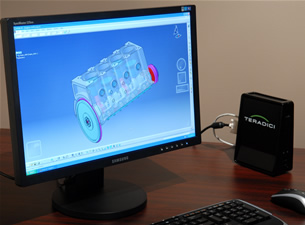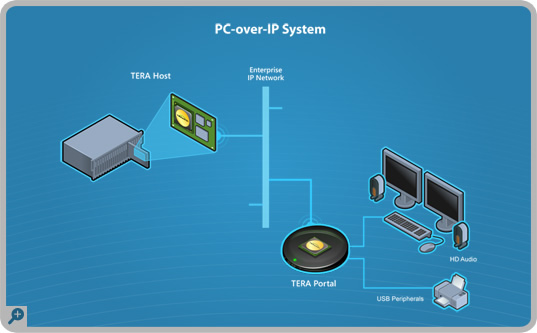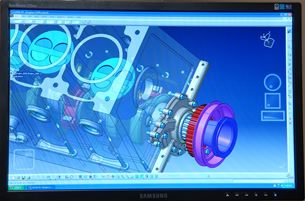Latest News
November 21, 2007
By DE Editors
 A CATIA engine block model is displayed remotely using Teradici’s PC-over-IP technology. The portal is connected to a workstation blade in the data center over a standard Ethernet network. |
The PC-over-IP chip from Teradici offers designers who need access to the power of their workstations during remote engagement frame rates of up to 60Hz.
Up until now, the computer performance needed for beefy graphics on the road, with all its specialized coding, was not available without bumps in the road, company spokesmen said. They say that is now solved by Teradici’s hardware interface, which offers support for any image interface including OpenGL, DirectX, and Aero, and is fully independent of operating systems and applications. In sum, the system enables seamless integration into existing IT environments with no drivers required and no impact on the host operating system.
 The PC-over-IP system includes a centralized TERA Host and a desktop TERA Portal connected by a wired or wireless enterprise IP network. Desktop PCs and workstations that incorporate a TERA Host are centralized in a secure location while TERA Portals connect displays and peripherals at the user’s desktop. |
Because this transfer of data is achieved without impact to host-CPU resources, the CPU is then free to run applications like CATIA or Autodesk. Now any image interface, application, or operating system can be supported over a standard IP network using the hardware chip, whereas earlier almost 40 percent of the CPU’s resources were taken up with encoding and applications software.
The bridge across networks means that the image on the screen is exactly the same as that on your workstation, and once the image is transferred over the network, no more traffic occurs to slow things down.
 |
PC-over-IP technology is capable of displaying stationary objects as perfect lossless images, which gives designers the ability to perform detailed engineering analyses. And due to the full 60Hz frame rate, a smooth rotation of manufacturing models provides a true workstation user experience during remote use. This can be critical for CAD designers who need to view such complex parts as engines or wings in rotational sequences away from their desks.
Security has also been addressed. Since the ability to secure valuable information is often at the discretion of IT managers, likewise authorization is required to access specific levels of the CAD/CAM models and data. So while PC-over-IP hardware-based USB bridging allows certain devices to operate without requiring additional drivers, access is denied to nonauthorized parties. For example, keyboards, 3D mice, and even SpaceBalls can be enabled, but access to DVD or flash drives can be prevented.
“By collaborating with Blade.org partners Devon IT and Teradici, IBM’s new Workstation Blade is the first in the industry to offer breakthrough and leading edge remote graphics acceleration.” — Tom Bradicich, fellow and VP of IBM Systems and Technology Group |
The folks at Teradici are ready for engineers who find they have a need for audio as well. In the meantime, the company spokesman explained that one of Teradici’s initial customers who is implementing the technology is IBM.
Referring to IBM’s incorporation of Teradici’s technology into its BladeCenter’s Workstation Blade, Tom Bradicich, fellow and vice president of IBM Systems and Technology Group, explained, “By collaborating with Blade.org partners Devon IT and Teradici, IBM’s new Workstation Blade is the first in the industry to offer breakthrough and leading edge remote graphics acceleration. Using hardware compression techniques in the render and transfer of display graphics from the server-based client to the desktop device, we provide remarkable and uncompromised video and complex image quality and performance.”
This system offers such a host of advantages that it seems the technology was developed with design engineering in mind.
Click here to “View the True Experience IT Demonstration” from Teradici’s homepage.
Click here for details on the EK1000 Evaluation Kit (15-day trial).
Click here for more on the TERA chipset.
Click here to access “Benefits of PC-over-IP Technology” and three other whitepapers.
Click here to read about other companies (IBM, Devon IT, ClearCube, Verari, AMD) that are using Teradici’s technology.
To read a related article on DE Online, go to “Teradici Delivers PC-over-IP Technology,” October 26, 2007.
Subscribe to our FREE magazine, FREE email newsletters or both!
Latest News
About the Author
DE’s editors contribute news and new product announcements to Digital Engineering.
Press releases may be sent to them via [email protected].






